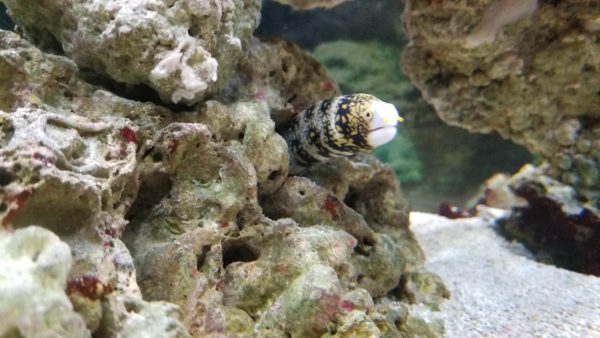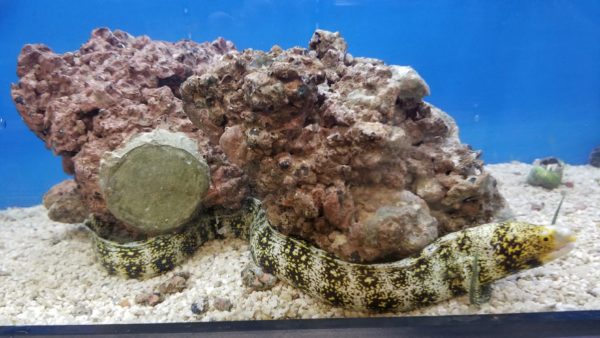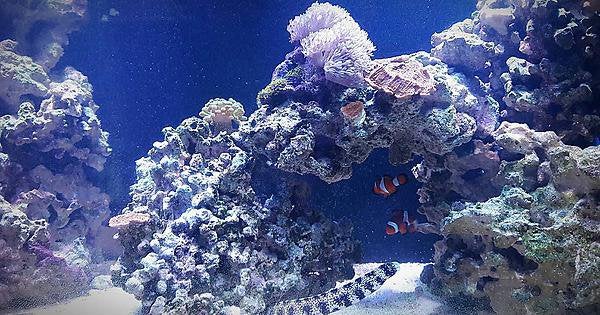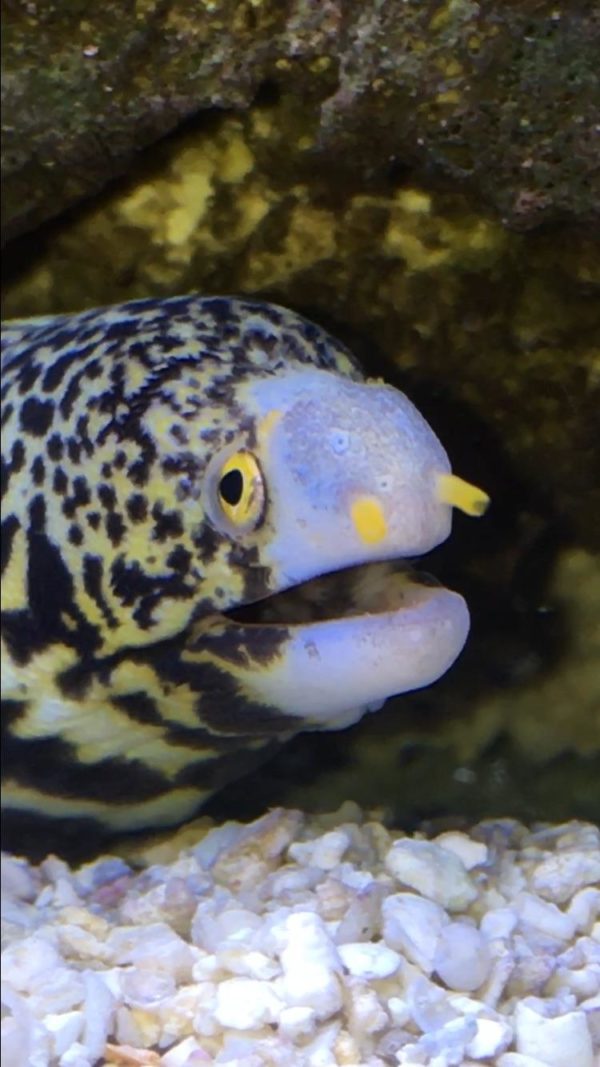Table of Contents
Snowflake Eel Overview
The sea is home to millions and millions of animal species. The good news is, now some of these sea animals can be reared within the comfort of the home, as pets. With a well-stocked tank, the aquarium can be an ideal home for the Snowflake eel.
A colorful tank pet that can grow up to 30cm in length, this sea animal is known by various names, including snowflake moray, floral eel, and zebra moray eel. It is a really cute tank pet if well cared for.
Eels often develop a very bad reputation because they are saltwater carnivorous creatures. However, that is not the problem because snowflake eels make a great addition to your tank. All you need to do is take care of them the right way.
This guide will walk you through all the important steps you need to know about taking care of snowflake eel and other important details.
| Information Chart | Snowflake Eel |
| Scientific Name | Echidna Nebulosa |
| Family | Moray eel |
| Care level | Intermediate to Advanced |
| Temperament | Semi aggressive, territorial |
| Color | White body with black spots |
| Lifespan | Up to 15 years |
| Size | Up to 2 feet |
| Diet | Carnivore |
| Minimum Tank Size | 55-75 gallons |
| Temperature | 72 to 78 degrees Fahrenheit |
| Water conditions | Saltwater with filtration |
| Tank mate compatibility | Large fishes with similar temperament |
Appearance of Snowflake Eel

The eel has an almost cylindrical shape. A first-time glance may reveal a snake-like appearance. The long and lithe body is graced with ornamental patterns. Along with its profile are white, yellow, and cream-like dots.
Other features worth noting are:
- Yellow eyes with a dark spot in the middle. The eyes are close to the mouth
- A dotted head with black, white, and yellow dots
- Protruding white lips that resemble that of the penguin. Most of the time, these lips remain open
- Strong teeth that help it to crush its meals
These carnivores are found to grow up to 3 feet in the wild, which shows that you do need to arrange for a large tank if you want to keep them safe. Often known as snowflake moray eels, these eels have a blend of cuteness with scary-looking features (mimicking that of a snake).
So, if you aren’t a big fan of snakes, we’d recommend steering clear off of this variant. The brown spotted markings with white spots are what give them a characteristic look that they have. Pair that with the gold-rimmed eyes, and you have a pretty distinctive-looking fish around in the tank.
Lifespan of Snowflake Eel
The typical lifespan of a snowflake eel is 4 years in captivity. However, there are instances when aquarists have found them living up to 15 years as well. It very well depends on the kind of care and food they are getting while growing in captivity.
Snowflake Eel Size
The snowflake eel typically grows up to 2 feet in captivity. This is smaller as opposed to how long they grow in the wild. However, since they are termed “semi-aggressive” fish, you need to ensure that they are kept in a large tank with enough space to move around without any restrictions of any kind.
Natural Habitat and Origin
The snowflake eel is native to the Indo-Pacific Ocean reefs. It inhabits the tropical waters of Africa and the Red Sea. It can also be found on the American West Coast. In the wild, it is known to live in rock crevices and caves. Countries, where it can be found, include Hawaii, Australia, and the East Indies.
They are predominantly found around the reefs and are predators in their natural habitat. They are found in abundance in Micronesia, Mexico, and even Central America.
However, when getting them for your home aquarium, one factor worth considering is the range of tank mates. Since they are predators in the wild, you need to avoid pairing them with fish species that they typically feed on. Avoid putting them with other reef species because they will gobble them down.
One unique feature of this fish species, especially because of their wildlife, is changing color throughout life. Typically, a white body with black speckles is the standard. However, there are a few variants that change color and feature yellow spots on the body too.
They are bottom dwellers like they are in the wildlife and like to stay at the bottom of the tank. In their natural habitat, they stay 7-100 feet deeper into the sea or ocean they are in.
Snowflake Eel Care and Tank Set-up

The eel is adaptive to most environments. It is largely disease-resistant and can live comfortably in an aquarium with the right tank conditions. If well-fed, it can grow quite tremendously within a very short time. For this reason, it is often advisable to acquire a big tank once to avoid the inconvenience of having to look for a sizeable one each time it outgrows its current one.
A snowflake eel should do impeccably well with the following tank conditions:
Optimum Tank Size for Snowflake Eel
The recommended tank size for snowflake eel is between 55-75 gallon tanks. Since they easily grow up to 2 feet, it isn’t even a question that they need a free and open space to comfortably move around and stay in.
Also, since eels are extremely slippery fishes with sleek and smooth bodies, you need to house them in an aquarium with a tightly sealed lid.
Filter Type
Although snowflake eels are bottom dwellers, they are notorious for being extremely active during the night. You will often find them intrigued by their surroundings. And, this can lead to accidents. They tend to get themselves in places or situations that aren’t for them.
This is the reason why aquarists need to be highly cautious of the water filters they are installing. Get the tightly sealed ones and won’t hurt the fish when they are moving around in the tank.
Besides a standard water filter, experts also suggest installing a chemical filter. This is to remove any water impurities or waste that could be harming the eel’s health.
Substrate
Snowflake eels, like several other eel species, don’t enjoy the sand. Even though they are bottom dwellers, they don’t enjoy finger gravel in the tank.
However, if you do have to fill the tank with a suitable substrate, rocks, and gravel stones. But, make sure that you secure the rocks because your eel will free flow around in the tank and topple them around.
Sizeable rocks with crevices offer an ideal hiding place. Remember, it loves to move incognito, making it necessary to create several caves for this venture. The rocks should be sturdily placed into the aquarium to avoid them getting dislodged. The eel is strong and may easily interfere with weak rock structures.
The base rocks often serve as a hiding spot for the eel to find a comfortable place to relax. If you can’t find the right ingredients to secure the whole stack of rocks, secure the base rock, which is a lot sturdier.
Water Parameters for Snowflake Eel
The water parameters are not very strict as snowflake eel can adapt to the surroundings they are in. However, knowing about the basic water parameters makes it easier for the aquarist to give the fish a comfortable and long life.
Water temperature
The ideal water temperature for snowflake eel is 72 to 78 degrees Fahrenheit. This indicates that they do enjoy a colder water temperature to live in.
pH Level
The perfect water pH level for Snowflake eel is 8.1 to 8.4. This is ideally an alkaline water pH, which they have in their natural habitat in the reefs.
Water hardness
The water hardness should be between 8 and 12dGH. Also, the salinity should be maintained between 1.020 and 1.026.
Snowflake Eel Tank Landscape

Housing a snowflake eel is no joke because it requires constant care, and you need to optimize their tank. Although they adapt well to the environment, some basic requirements are considered an absolute must.
When setting up their tank, there are a few quintessential pieces that need to be added. Since snowflake eels are active during the night, you need to add caves for them to rest in during the day. A minimum of 3-4 caves is considered ideal. Also, when setting up caves, focus on variety.
Despite being considered predators, these fishes love to hide out from their surroundings. You will often find them moving around in the tank, hiding away their body and simply trying to peek out of the cave with their head.
Although they are nocturnal species, you will generally find them during the day rhythmically swaying their body around the rocks. So, it doesn’t matter what you add or don’t add in the tank; rocks and caves are a must.
Also, besides the additions to the tank, ensuring that the tank is clean is important too. Water changes are crucial every one to two weeks, depending on the waste accumulated. Besides that, focus on investing in a good water filtration system for the tank.
Moreover, when introducing a snowflake moray eel to the tank, ensure that you acclimatize them slowly instead of being rigorous about the process.
Feeding Snowflake Eel
The snowflake eel is described as a carnivore because of its penchant for flesh. If kept in a tank with small-sized fish, it can gobble them up if there is a delay in offering its feeds or when it is underfed. It is also a predator that hides in rock crevices to await anything that can make a delicious meal. Choice of tank mates must therefore be done carefully.
Some of the feeds that auger well with the eel include:
- Dried or frozen krill
- Shrimp meat
- Clams
- Squid
- Octopus
- Many types of meaty foods
Add some vitamins to the fleshy meals to help it develop stronger disease resistance. Certain feeds can be dangerous to the eel. These are rosy reds and goldfish. They should not be offered to the pet as they can lead to liver damage.
If you are adding freshwater fish to the tank as a meal or snack, be assured they won’t respond well. Reports even suggest that feeding them freshwater fishes like goldfish and rosy redfish can lead to liver dysfunction.
Also, in the process of trying to build a “relationship” with the moray eel, you might want to hand feed them. While the thought is nice, execution is key in this process. Since they have visible teeth and are carnivores, you need to be mindful. You always need to take an informed step. If required, ask experienced aquarists or the shop owner you bought the fish from.
If you find the snowflake eel charging towards your hand to grab the food, you need to remove it immediately. If the snowflake eels show signs of aggression, they can bite on the flesh that causes infections later.
So, when feeding them, use tongs. Also, for the frequency, it is typically once every two weeks. However, they can demand more food during their active spells. Also, experts suggest feeding them during the night when they are active. It distracts them enough to not feed on their tank mates.
Snowflake Eel Behavior and Temperament
Although the snowflake moray eels are deemed safe enough to house in home aquariums, we’d still suggest being careful. They are carnivores and mildly aggressive by nature. And, just because they are being bred and grown in captivity doesn’t mean they will forego their instincts.
So, it is common for them to show signs of aggression, feed on their tankmates, and even charge the hands feeding them. However, don’t get deterred by it because that’s not what our intention is.
If given the right care, proper diet, and water parameters, these fish keep to themselves without questions.
One of the unique behavior traits is their propensity to jump out of the tank. This is why experts suggest housing them in larger tanks with a closed lid. You will often find them exploring their vicinity, trying to get into spots that aren’t meant for them.
So, if you have any kind of opening in the tank, be it from a water filter or other sites, you must fill them with a sponge. This ensures they can’t slip out of the tank, reducing the risks of injuries to their bodies.
Snowflake Eel Tank Mates
Snowflake eels are predators that hunt most types of sea animals, including small fish and shrimps. Keep them with bigger fish like the wrasses, tangs, triggerfish, and lionfish. Considered less aggressive, they can be housed with other eels provided they are introduced into the tank simultaneously. This is important as, like most other types of animals, they tend to be territorial.

Avoid placing smaller animals like crabs, lobsters, shrimps, and other groups of crustaceans. The eel thrives best on a crustacean diet and will gobble them all up. However, they can be housed together with sea anemones, starfish, and sea urchins. They are also known to be friendly to corals and will rarely interfere with them.
If they are too hungry, they will gobble down their smaller tankmates. So, avoid pairing them with fishes that are small enough to fit inside their mouth. Typically, they do well with larger or similar-sized fish with a similar temperament.
Ideal Snowflake Eel Tankmates
- Butterflies
- Large gobies
- Lionfish
- Puffer fish
- Large damsels
- Triggerfish
- Large tobys
- Wrasses
If you had to get a big no to tank mates, avoid crustaceans at all costs. Despite their size, a snowflake eel will try to feed on them and cause them distress and premature death in the process.
Breeding Snowflake Eel
The snowflake eel is an interesting sea animal as it is protogynous. The dominant eel is likely to change from male to female and vice versa. Of course, this process may take a long time, from many months to a year.
Differentiating the sexes is not easy, same to breeding them in captivity. They are considered egg scatterers. Their eggs are produced in the middle of the water during those rare ritual-mating incidences. These eggs drift in the water before settling onto the reef to hatch. After a few days, the fry begins to swim in the water. So far, not much is known about breeding them in captivity.
Another marker that makes the breeding process difficult is their aggression and fight for dominance. This means that keeping two eels in the same tank is very difficult. This results in difficulty in the breeding too.
Since the snowflake eels are pelagic spawners, they spray the eggs directly into the water. The oil droplet in individual eggs keeps them afloat till they hatch. And, once they hatch, the small eels form an alliance and metamorphose multiple times.
If you are considering breeding two snowflake eels, you have to be extremely patient. You need two stable eels for successful breeding. Typically, the more dominant eel is considered male.
In the tank, the dominant male is surrounded by female eels, forming his harem. The male snowflake eel then mates each one of the female ones in turn. Facts also suggest that the snowflake moray eels are the “easiest” to breed among other eel species.
Snowflake Eel Common Diseases and Their Treatment
Unlike most other tank fish species, snowflake eel doesn’t have a thick outer covering with scales. This makes their direct skin susceptible to chemicals and medications the tank water is treated with. So, try to avoid them as much as possible.
Another common issue with snowflake eels is that they develop infections very quickly. If you notice anything amiss with their behavior and activity, it is a sign of infection. In that case, you need to check the water parameters and change them immediately.
Snowflake eels are quite hardy, provided you are taking care of them the right way.
Facts about the Snowflake Eel
- It has poor eyesight even though its eye looks quite sharp.
- It becomes relatively aggressive during feeding times. If feeding it from the hands, one must be very careful as it has a very painful bite.
- If a hobbyist occasionally feeds it from the hand, it gets accustomed to this. With time, it begins to associate the hand with food. This can lead to injuries as it may hurt the hand when cleaning the tank, thinking it is being denied food.
- For the first few weeks after introduction to the aquarium, it is likely to be very shy. During this time, it will hide a lot. Caves and rock crevices will help tremendously during this time. As it gets accustomed to its new surroundings, it begins to get out of hiding more.
- Avoid over-feeding the eel as this could hurt its system.
- There are times when it can stay for days without eating. If it is healthy and shows no sign of poor health, it should not be a call for alarm.
Are Snowflake Eels Right for You?
This is a common question that most people have. Despite the challenges, is snowflake eel the right fit for every home aquarium?

Well, the answer is subjective. Do you have a big enough aquarium to accommodate them? Are you ready to pair them with tank mates that are suitable for them? Are you willing to learn the ways to take care of them?
Several questions need answering before you consider adding a snowflake eel to your tank. In that case, we’d highly recommend that you assess the pros and cons first. If you think your answers lean more towards a positive side, go for it. If not, there are a lot of other fish you can consider buying.
FAQs
How long do snowflake eel live in captivity?
Although the standard lifespan is 4 years, with the right care, they can even live up to 15 years in captivity like they do in the wild.
Can a snowflake eel live with clownfish?
Although many people have varying opinions, clownfish can be a good tank mate with snowflake eel. However, you need to be vigilant because if the eel is hungry and doesn’t want to wait till feeding, it might eat the clownfish.
Can two snowflake eel stay in the same tank?
This depends on the size of the tank. If you have a huge aquarium with a capacity of over 100 gallons, you can house two snowflake eels together. However, ensure that they are both introduced to the tank at the same time. If you add one later, the pre-existing one can become territorial and aggressive towards the newly introduced eel.
Conclusion
The snowflake eel is a unique pet with outstanding features that makes it a great aquarium addition. However, we understand that you might have a lot of questions. It is okay, though, because it is a common thought process.
Understand that snowflake eels do have a bad reputation, but they aren’t a bad species to house. You just need to follow the right instructions, feed them the correct food, and house them with proper tank mates. With these, you should not face any issues housing them in your home aquarium.
No related posts.

1 thought on “Snowflake Eel: Full Care Guide, Breeding, Tank Size & Disease”
I have had a snowflake eel for several months now and she recently changed her eating habits. As a juvenile she would eat every other day and occasionally every day. Then as she grew older these times spread out. However she hasn’t eaten in 3 weeks now! She still appears from time to time and she SEEMS healthy. But is it Normal for them to go weeks without feeding? I’ve tried her normal squid, krill and silversides to no avail.